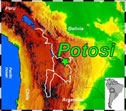

|
|
|
| "Koala Mine Tours Motto: Not for wimps or wussies." Melissa Giovanni | |
|
Cerro Rico Mine |
Geology - Potosi |
Cerro Rico Silver Mine
Cerro Rico is one of the world's finest examples of economic geology, as well as a testament to the harsh working conditions that Bolivians deal with on a daily basis. We were given the opportunity to tour the Cerro Rico mine through Koala Tours. This tour was a once in a lifetime opportunity to witness first hand a working mine, whose operations consist mainly of manpower, for there are few machines doing the dirty work. The temperatures are extreme, the walls are muddy and slippery, and tunnel floors are flooded. The ceiling is just a few feet above the floor at many points, and the only way through is on your belly. Men and boys pull carts full of rocks, shovel rocks into sacks which are heaved up several levels for removal, all by hand. The miners constantly chew coca leaves, helping them stand the overwhelming heat and prevent them from being hungry.
Typically, "tourist" activities are designed so anyone could tag along, but the Cerro Rico mine tour is definitely an exception. Upon first entry into the mine you feel a cool draft, but within 50 meters of the entrance the heat begins to rise, and within minutes you are sweating profusely.
The first stop is the mine "shrine" where you are introduced to a statue of "El Tio", where miners bring offerings such as cigarettes, coca leaves, and alcohol. The miners believe that El Tio (the devil) lives underground and controls the mine and its economic value. They ask the devil for a successful prospecting and request that he blesses the mine with good fortune and high production.
Following the shrine, you descend further down into the mine. The ceilings drops and you eventually find yourself crawling on your hands and knees. Tunnels have sharp drops to the sides, so you have to constantly pay attention to everything around you. Ladders will often take you down to the next level, and in some cases, a steep descent is the only option. We were fortunate enough to run into two miners pulling a cart. They swept two of us up in the cart and brought us on an unforgettable mine cart ride into the darkness.
Farther into the mine, we found a miner tapping into the walls. The hole needed to be about 3 feet deep, and only centimeters in diameter, such that a stick of dynamite would fit inside. Witnessing the painstaking work that went into digging such a hole using only a metal stick and sledgehammer was amazing. Before beginning the ascent out of the mine, we took a turn down a random tunnel to help out some miners who were filling large buckets with rocks, which were being hauled to a higher level by other miners, whom we could not see or hear. A few of us participated by shoveling the rocks into the bins, but quickly grew tired. Imagine holding that shovel for 14 hours.
Coming out of the mine was painful, because after 3 hours inside, we had lost perception of how far into the mine we had gone, and the exit seemed an endless distance away. We had been exposed to extreme temperatures, having been down to level 4, which was well over 120 degrees. Lunchtime had come and gone, and everyone was aching from crawling in a hunched position for the past few hours. The light at the end of the tunnel was a relief and a disappointment all in one. Experiencing a working mine first hand is something that none of us will soon forget.
|
Culture - Potosi |
City Scenes |